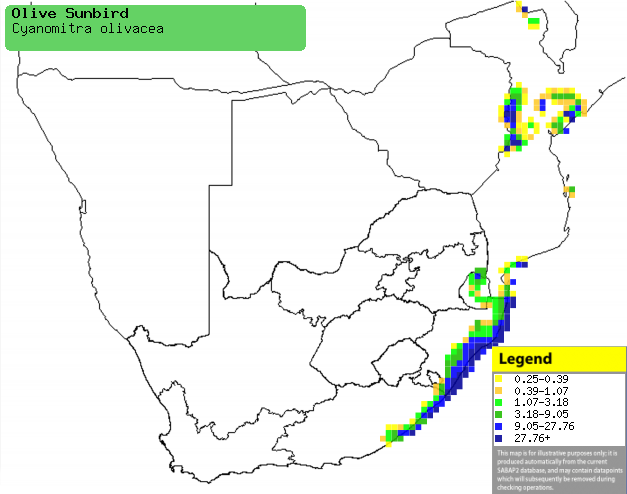|
Cyanomitra olivacea (Olive
sunbird)
[= Nectarinia olivacea]
Olyfsuikerbekkie [Afrikaans]; Olijfgroene honingzuiger [Dutch];
Souimanga olivâtre [French]; Olivnektarvogel [German]; Beija-flor-oliváceo
[Portuguese]
Life
> Eukaryotes >
Opisthokonta
> Metazoa (animals) >
Bilateria >
Deuterostomia > Chordata >
Craniata > Vertebrata (vertebrates) > Gnathostomata (jawed
vertebrates) > Teleostomi (teleost fish) > Osteichthyes (bony fish) > Class:
Sarcopterygii (lobe-finned
fish) > Stegocephalia (terrestrial
vertebrates) > Tetrapoda
(four-legged vertebrates) > Reptiliomorpha > Amniota >
Reptilia (reptiles) >
Romeriida > Diapsida > Archosauromorpha > Archosauria >
Dinosauria
(dinosaurs) > Saurischia > Theropoda (bipedal predatory dinosaurs) >
Coelurosauria > Maniraptora > Aves
(birds) > Order: Passeriformes
> Family: Nectariniidae
Distribution and habitat
Occurs in West Africa and across the DRC, extending south
through Tanzania, Zambia and Malawi to southern Africa. Here it is common in
central and southern Mozambique and Swaziland, extending down the coast to
KwaZulu-Natal and the Eastern Cape. It generally prefers coastal evergreen
forests and thickets, but it also occupies dense woodland, banana and
Eucalyptus plantations and well-wooded gardens.
|
 |
|
Distribution of Olive sunbird in southern Africa,
based on statistical smoothing of the records from first SA Bird Atlas
Project (©
Animal Demography unit, University of
Cape Town; smoothing by Birgit Erni and Francesca Little). Colours range
from dark blue (most common) through to yellow (least common).
See here for the latest distribution
from the SABAP2. |
Food
It mainly feeds on nectar and arthropods, gleaning prey
from foliage and spider webs and hawking insects aerially. The following food items have been recorded
in its diet:
- Plants
- nectar
- Strelitzia nicolai (Coastal strelitzia)
- Burchellia bubalina (Wild-pomegranate)
- Erythrina (coral-trees)
- Scadoxus (lilies)
- Halleria lucida (Tree-fuchsia)
- Leonotis leonurus (Wild dagga)
- Hibiscus tiliaceus (Lagoon hibiscus)
- Jacaranda mimosifolia (Jacaranda)
- Kigelia africana (Sausage-tree)
- Schotia brachypetala (Weeping boer-bean)
- Gardenia (gardenias)
- Fuchsia
- Passiflora (granadina)
- Tecoma (honeysuckles)
- Macaranga (wild poplars)
- Loranthaceae (mistletoes)
- fruit
- Trema orientalis (Pigeonwood)
- juice sucked out of Ficus lutea (Giant-leaved fig)
- Arthropods
Breeding
- The nest is built solely by the female, consisting of an elongate,
pear-shaped structure made of a variety of materials, such as fine grass,
twiglets, moss, lichen, leaves and Marasmius fungus bound together
with spider web. The entrance hole is placed on the side, covered by a small
roof, while the interior is typically lined with feathers, seed down and
other fine fibres. It is typically attached at the roof to a branch or
creeper beneath a dense canopy, or alternatively it can be put amongst roots
and cavernous hollows on the ground in the forest or beside a stream, or
even within a building or in a hanging basket.
- Egg-laying season is from August-March, peaking from September-January.
- It lays 1-3 eggs, which are incubated solely by the female for about
13-16 days.
- The chicks are fed by both parents, leaving the nest after about 13-16
days.
Threats
Not threatened globally but Threatened in southern
Mozambique, largely due to the destruction of coastal forest.
References
-
Hockey PAR, Dean WRJ and Ryan PG 2005. Roberts
- Birds of southern Africa, VIIth ed. The Trustees of the John Voelcker
Bird Book Fund, Cape Town.
|
